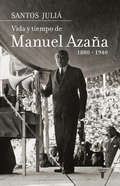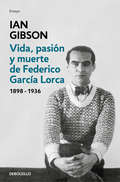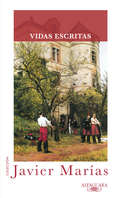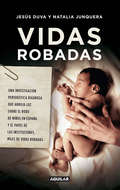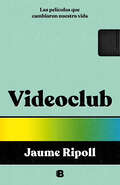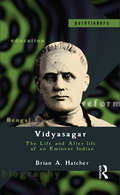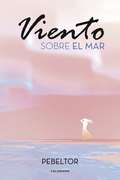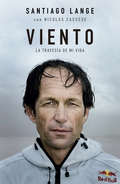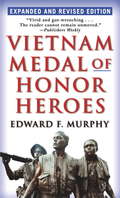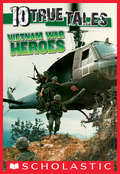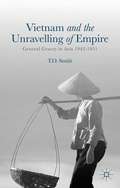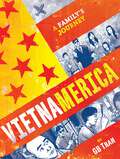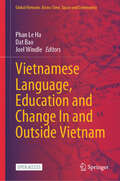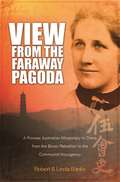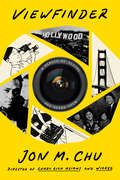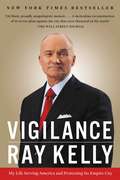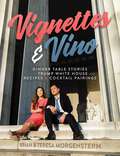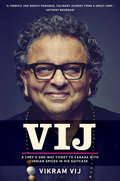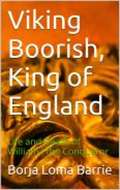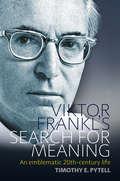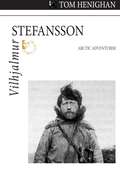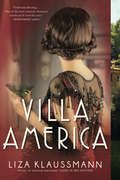- Table View
- List View
Vida y tiempo de Manuel Azaña. Biografía
by Santos JuliáLa biografía definitiva de una figura fundamental para entender el siglo XX. Manuel Azaña ya no es un desconocido como le parecía a su cuñado, Cipriano de Rivas Cherif, cuando acometió la tarea de contar por primera vez su vida. No lo es porque los libros y artículos sobre su persona y significación política han sido abundantes desde los años de la Transición a la democracia. Sin embargo, este mejor conocimiento de Azaña ha sufrido los vacíos de una tardía y fragmentaria recuperación de toda su obra y de sus papeles inéditos, sometidos a excesivos avatares de la fortuna e inaccesibles hasta fechas recientes a los investigadores. La publicación de todos esos papeles permitía, y casi exigía, contar su vida sobre la base de la nueva documentación disponible. La infancia y primera juventud, su trabajo en el Ateneo de Madrid, su militancia de diez años en el Partido Reformista, su obra de creación y crítica literaria, sus vínculos familiares, los círculos de sus amistades, sus gustos y aficiones, los años de gobierno y oposición y, en fin, su política de paz durante la Guerra Civil y la persecución a la que fue sometido en el exilio reciben en este libro una nueva luz proyectada a partir de la cantidad y calidad de la documentación reunida por vez primera en la nueva edición de sus obras completas.
Vida, pasión y muerte de Federico García Lorca
by Ian GibsonNueva edición revisada de la célebre biografía de Federico García Lorca escrita por el hispanista Ian Gibson. Esta biografía sobre Lorca, mundialmente aclamada, enriquecida con nueva información, nos ofrece las claves de uno de los genios más apasionantes y más queridos del siglo XX, un revolucionario sin carnet, que cantó al derecho del individuo a su propia vida, a su propio erotismo, a su libertad. Estar al lado de los marginados le condenó a muerte y, por mucho que pasen los años, su obra sigue más vigente que nunca. Reseña:«La novela verdadera y trágica de la vida de Federico García Lorca no puede contarla ya nadie sin tener presente la aventura de indagaciones a la que ha dedicado tantos años Ian Gibson.»Antonio Muñoz Molina
Vidal in Venice
by Gore VidalThe history of Venice, interspersed with the author's journey there in 1981.
Vidas escritas
by Javier MaríasVeintiséis breves e irreverentes retratos de grandes escritores que se han convertido en la más divertida, melancólica y fascinante invitación a leer. Faulkner a caballo, Conrad en tierra, Isak Dinesen en la vejez, Joyce en sus gestos, Stevenson entre criminales, Conan Doyle ante las mujeres, Wilde tras la cárcel, Turgueniev, Mann, Lampedusa, Rilke, Nabokov, Madame du Deffand, Rimbaud, Henry James, el gran Laurence Sterne... Hasta un total de veinte genios de la literatura resucitan en estas breves e insólitas biografías, que se leen como cuentos gracias a la precisión, amenidad y elegancia de la prosa de Javier Marías. Todos son extranjeros, todos están muertos y todos han sido tratados como personajes de ficción, con un afecto y una ironía no exentos de profundidad. El volumen se completa con seis retratos de «Mujeres fugitivas», que vivieron y murieron por encima de sus posibilidades, con tanta intensidad como humor. Y lo corona «Artistas perfectos», el contrapunto de las anteriores semblanzas: sus imágenes detenidas prescinden de anécdotas y caracteres para subrayar, en frases como relámpagos, la expresividad de los rostros, ademanes y gestos, espontáneos o artificiales, de los artistas que sólo en la posteridad alcanzan la perfección. Los textos van acompañados de extraordinarios retratos, pertenecientes en su mayoría a la colección del autor. Reseñas:«Cuesta contenerse ante el encanto de estos breves retratos... Exquisitos y astutamente irónicos. Un libro encantador.»Michael Dirda, The Washington Post «Al leerlas, se cae de un modo insólito e inesperado en una sensación de éxtasis.»The Washington Times «Una maravilla que exige lecturas y relecturas.»Antón Castro, El Periódico «Marías es un escritor demasiado diestro como para acometer algo como una tediosa teoría de la biografía. [...] Para Marías los grandes escritores no son enigmas por resolver, pero sí paradojas para saborear. De hecho, muchas de estas "vidas escritas" comienzan con una paradoja.»Christopher Benfey, The New York Times Book Review «Una lectura curiosa y gratificante. La voz segura e irónica de Marías junto con su perspicacia hacen que merezca la pena su lectura.»Jamie Berger, San Francisco Chronicle «Vidas escritas prueba lo cautivador, inteligente y original que es Marías como escritor... El éxito del libro se basa en el estilo y el tono, y Marías, cuyo sello es la precisión socarrona, cumple las expectativas con rigor y garbo.»Sarah Emily Miano, The Observer «Tengo la corazonada de que Vidas escritas, de Javier Marías, será considerado un texto de referencia en la historia de la biografía.»Carl Rollyson, The New York Sun «Marías humaniza a estos autores imprescindibles y entra en su leyenda para contar de ellas cotidianidades e iluminar lados dudosos, mas no banalidades. El resultado es una mejor comprensión de aquellas vidas vistas aquí con "afecto y guasa", y no exentas de ironía.»Winston Manrique, Babelia «Vidas escritas es una autobiografía acerca de otros, un viaje alrededor del cuarto de Javier Marías: en las fotos enmarcadas de las paredes, el autor aparece disfrazado unas veces de William Faulkner y otras de Henry James.»Benjamín Prado, Diario 16
Vidas robadas
by Jesús Duva Natalia JunqueraUna investigación periodística rigurosa que arroja luz sobre el robo de niños en España y el papel de las instituciones. ¿Mi hijo murió o me lo robaron? Sus maridos no las creyeron. Pensaron que el dolor por haber perdido a un hijo les hacía sospechar algo imposible: que aquellos doctores, que aquellas monjas sonrientes les habían quitado a sus bebés recién nacidos. Con el tiempo muchas de aquellas mujeres se convencieron de que la desaparición de sus pequeños obedecía sólo a la fatalidad, hasta que una de ellas habló para recordar en voz alta sus dudas y otra madre las compartió desde otra ciudad. El robo de niños en España y el papel de las instituciones en ellos se han venido silenciando en los últimos tiempos por los diferentes gobiernos y por la fiscalía, pero la voz de las víctimas se ha impuesto a la indiferencia y al oscurantismo. Hoy más de milfamilias españolas están convencidas de que les robaron a sus hijos en las clínicas donde los alumbraron. Jesús Duva y Natalia Junquera, reputados periodistas del diario El País, nos ofrecen en Vidas robadas un retrato escalofriante de las tramas de adopción irregular -separación de gemelos, compraventa o exportación de niños- que operaron en España desde el final de la Guerra Civil hasta los años 90, resultado de una documentada investigación periodística que se inició en 1981. Una serie de historias de madres despojadas y de niños robados que luchan por destapar la verdad y por recuperar los pedazos de las vidas que les quitaron impunemente. «Cuando la justicia olvida a las víctimas, deja de ser justicia para convertirse en un instrumento de impunidad. Este libro pone voz y forma a la esperanza de las víctimas».Baltasar Garzón
Videoclub: Las películas que cambiaron nuestra vida
by Jaume RipollUNA HISTORIA DE PELÍCULA DE LA MANO DEL COFUNDADOR DE FILMIN Esta es la historia de un niño con sobrepeso y acné que se despertaba de madrugada para ver películas. Esta también es la historia del padre de ese niño, propietario de videoclubs, coleccionista de VHS y el hombre que pensaba que la mejor educación para su hijo era el cine. Esta es la historia de cómo el cine puede cambiar nuestras vidas y hacerlas mejores.Jaume Ripoll, cofundador de Filmin -una de las plataformas de cine más prestigiosas de los últimos tiempos- nos relata en este libro su historia de amor incondicional con el séptimo arte. De su mano, volveremos a los videoclubs de barrio en un recorrido nostálgico y fascinante lleno de anécdotas y recomendaciones que nos harán (re)descubrir y recuperar las obras imprescindibles que marcaron varias generaciones. «He hecho un viaje de espectador a distribuidor, del placer al trabajo, y ahora escribo este libro con la esperanza de que restaure parte de la ilusión perdida y permita al lector descubrir y recuperar obras que posiblemente han significado tanto en su vida como lo han hecho en la mía. Al fin y al cabo, el cine es una experiencia solitaria que se disfruta en compañía». La crítica ha dicho:«Jaume Ripoll nos ofrece una panorámica certera de los últimos 30 años de cine en este país; del siglo XX al XXI, entre rebobinados, recs y pausas. Un libro que es autobiografía, novela de aprendizaje y manual de supervivencia. Lleno de gracia e inteligencia, respira amor por el cine en cada página».Jonás Trueba «Una emocionante celebración del cine».El Periódico«Un libro rebosante de nostalgia, anécdotas, confesiones, reflexiones sobre el devenir de una industria cinematográfica… un canto de amor al cine».David Gallardo, Infolibre «Un conmovedor homenaje al cine».Vogue «Unas deliciosas memorias».Oskar Belategui, El Correo«Muy interesante».El País «Una delicia que se acaba demasiado pronto».Saltos de Eje
Vidyasagar: The Life and After-life of an Eminent Indian (Pathfinders)
by Brian A. HatcherThis book offers a new interpretation of the life and legacy of the Indian reformer and intellectual, Ishvarchandra Vidyasagar (1820–91). Drawing upon autobiography, biography, secondary criticism and a range of Vidyasagar’s original writings in Bengali, the book interrogates the role of history, memory and controversy, and emphasises the key challenge of pinning down the identity of an enigmatic and multi-faceted figure. By examining lesser-known works of Vidyasagar (including several pseudonymous and posthumous works) alongside the evidence of his public career, the author calls attention to the colonial transformation of intellectual and social life, the nature of life writing, the limits of standard biographies and the problem of modern Indian identity as such. Based on decades of research and an original perspective, this book will be especially useful to scholars of modern Indian history, biographical studies, comparative literature and those interested in Bengal.
Viento sobre el mar
by PebeltorLo tenía todo perdido, y su último recurso quizás fue aún peor. Es la propia naturaleza del incentivo, donde el mayor hallazgo son las fisuras del ojo público y los apuntes de las cabezas hacia el infinito. <P><P>Violencia de género y enfermedades de las más atroces, como el querer curar a alguien matándolo y no poder, en definitiva, yermas comunicaciones: «que no te dé miedo luchar por lo que deseas». Ella es como una yegua joven, morena y hermosa como la que más; y él un funcionario decidiendo lo suyo. A la dama la cabeza le dice una cosa y el cuerpo otra. <P><P> El dinero le encanta: fue meretriz y panadera, ya no se da a los quijotes falsos. Comparte esa sedación azul y carcelaria del otro; incluso, ese Paseo del Arte madrileño donde anidan sus paralelismos diciendo «aquí estoy yo». <P><P> Entonces, surgen dos interrogantes repletos de inquina:¿qué hacemos con los ancianos? ¿Qué es imperdonable? Dos preguntas del color de las rosas negras. La muchacha compartiría ese «A mí no me ha gustado nunca Dios», y se desnuda llenando de malos suspiros las almohadas. Bodas de sangre. Pequeños gestos que cambian el mundo frente a un solo cadáver recuperado.
Viento: La travesía de mi vida
by Nicolás Cassese Santiago LangeSantiago Lange, uno de los más grandes regatistas mundiales, recorre en detalle su vida; desde su infancia en San Isidro, donde dio sus primeros pasos como navegante, hasta los Juegos Olímpicos de Río de Janeiro, en los que ganó su primera medalla de oro luego de haberse sometido a una operación de cáncer de pulmón. La medalla de oro de Río representa la conquista de un sueño que perseguí durante mucho tiempo. Ese podio olímpico no solo marca el punto más alto de mi carrera, sino que está ligado a las elecciones más importantes de mi vida. Sin que lo advirtiera, la línea que dividía mis días en el agua y mis días en tierra se fue borrando. Por eso, cuando me colgaron la medalla sentí que toda mi historia confluía en ese momento. Este libro cuenta la vida de uno de los más grandes regatistas, una leyenda deportiva mundial. Y cuenta también qué hay detrás de su glorioso regreso tras superar un cáncer de pulmón nueve meses antes de los Juegos Olímpicos de 2016. La de Santiago Lange es una historia de resiliencia y tenacidad; la de un hombre que enfrentó las adversidades para seguir persiguiendo sus sueños.
Vietnam Medal of Honor Heroes
by Edward F. MurphyMore than 100 compelling, true stories of personal heroism and valor- in a special expanded edition honoring courage in the face of war. Here are dramatic accounts of the fearless actions that earned American soldiers in Vietnam our highest military distinction--the Medal of Honor. Edward F. Murphy, head of the Medal of Honor Historical Society, re-creates the heroic acts of individual soldiers from official documents, Medal of Honor citations, contemporary accounts, and, where possible, interviews with survivors.Complete with a list of all Vietnam Medal of Honor recipients, this book offers a unique perspective on the war-from the early days of U.S. involvement through the return home of the last soldiers. It pays a fitting tribute to these patriotic, selfless souls.
Vietnam War Heroes (Ten True Tales)
by Allan ZulloTen true stories of real-life heroes of the Vietnam War!Twenty-eight soldiers--all but five badly wounded or dead in the first few minutes of a devastating ambush--are fending off 200 North Vietnamese soldiers. US platoon leader Lieutenant Hal Fritz shouts to his comrades, "We will never give up!"Dozens of severely wounded soldiers are trapped in a fog-shrouded outpost and under merciless attack by the enemy. No other medical helicopter pilot will dare attempt a rescue, except for Major Patrick Brady. These and other American heroes risked their lives serving their country in the Vietnam War. You will never forget their courageous true stories.
Vietnam and the Unravelling of Empire: General Gracey in Asia 1942-1951
by T. O. SmithThe Vietnam War and Indian independence devastated British policy towards Asia. The Labour Government failed to understand its commitments. Yet some senior British officers were prepared to work alongside Asian nationalism in order to secure British interests. This created a radical local fusion of imperial, diplomatic and humanitarian policies.
Vietnamerica: A Family's Journey
by GB TranA superb new graphic memoir in which an inspired artist/storyteller reveals the road that brought his family to where they are today: Vietnamerica GB Tran is a young Vietnamese American artist who grew up distant from (and largely indifferent to) his family&’s history. Born and raised in South Carolina as a son of immigrants, he knew that his parents had fled Vietnam during the fall of Saigon. But even as they struggled to adapt to life in America, they preferred to forget the past—and to focus on their children&’s future. It was only in his late twenties that GB began to learn their extraordinary story. When his last surviving grandparents die within months of each other, GB visits Vietnam for the first time and begins to learn the tragic history of his family, and of the homeland they left behind. In this family saga played out in the shadow of history, GB uncovers the root of his father&’s remoteness and why his mother had remained in an often fractious marriage; why his grandfather had abandoned his own family to fight for the Viet Cong; why his grandmother had had an affair with a French soldier. GB learns that his parents had taken harrowing flight from Saigon during the final hours of the war not because they thought America was better but because they were afraid of what would happen if they stayed. They entered America—a foreign land they couldn&’t even imagine—where family connections dissolved and shared history was lost within a span of a single generation.In telling his family&’s story, GB finds his own place in this saga of hardship and heroism. Vietnamerica is a visually stunning portrait of survival, escape, and reinvention—and of the gift of the American immigrants&’ dream, passed on to their children. Vietnamerica is an unforgettable story of family revelation and reconnection—and a new graphic-memoir classic.
Vietnamese Language, Education and Change In and Outside Vietnam (Global Vietnam: Across Time, Space and Community)
by Dat Bao Phan Le Ha Joel WindleThis open access edited book attempts to break new ground in investigating multiple facets of Vietnamese language, education and change in global contexts, engaging with global Vietnam through complex lenses of language and education. Issues of language, globalization, and global identities have often been framed through the lens of hierarchical/binary power relations, and/or through a dichotomy between hyper-central languages, such as English, and revisualized or marginalized local language and cultures. In this book, this dichotomy is turned on its head by considering how Vietnam and Vietnamese are constructed in and outside Vietnam and enacted in global spaces of classrooms, textbooks, student mobility, community engagement, curriculum, and intercultural contacts. Vietnamese is among the world’s most spoken languages and is ranked in the top 20th in terms the number of speakers. Yet, at the same time, as a ‘peripheral’ or ‘southern’ global language as often seen in the Global North-Global South spectrum, the dynamics of multilingual and multicultural encounters involving Vietnamese generate distinctive dilemmas and tensions, as well as pointing to alternative ways of thinking about global phenomena from a fresh angle. Rather than being outside of the global, Vietnamese - like many other ‘non-central’ global languages - is present in diasporas, commercial, and transnational structures of higher education, schooling, and in the more conventional settings of primary and secondary school, in which visions of culture and language also evoke notions of heritage and tradition as well as bring to the fore deep seated ideological conflicts across time, space, communities, and generations. Relevant to students and scholars researching language, education, identity, multiculturalism, and their intersections, particularly related to Vietnam, but also in Southeast Asia and beyond, this volume is a pioneering investigation into overlooked contexts and languages from a global, southern-oriented perspective."This book presents an eclectic collection of 15 chapters unified by an interest in developing and teaching the Vietnamese language. To my knowledge, there has been no previous attempt to make the national language of Vietnam a focus for as many perspectives as are documented in the book. In this regard, the book makes an original and intriguing contribution to the literature on Vietnamese culture, including the culture of Vietnam’s expanding diaspora. The book is pioneering in the extent to which it draws attention to the many roles played by a national language in a nation’s political, social and cultural development. It also documents the challenges of preserving a national language in settings where it is at risk of being marginalized. It is pleasing that so many of the contributing authors are young Vietnamese scholars who can provide a distinctly Vietnamese perspective on concepts and practices of global significance."- Dr. MartinHayden, Emeritus Professor of Higher Education, Southern Cross University, Australia "Vietnamese Language, Education and Change In and Outside Vietnam brings together an excellent collection of chapters that highlight the diverse and important but under-explored roles Vietnamese language plays in different settings within and outside Vietnam. The fifteen chapters of this much needed book provide unique insights into various aspects and meanings of Vietnamese language. Collectively, the volume contributes to broadening our view about the evolution and transformation of Vietnamese language under the impacts of local, national, regional and global forces. The book invites readers to engage in a reflective and intersectional approach to rethinking and re-examining our understandings of the changes and developments of Vietnamese language over the history of the country."- Dr Ly Tran, Professor, Centre for Research for Educational Impact (REDI), Deakin University, Australia, and Founder: Australia-Vietnam
View from the Faraway Pagoda: An Australian Missionary in China from The Boxer Rebellion to The Communist Insurgency
by Robert Banks Linda BanksThis book describes the life and service of an inspiring woman, Sophie Newton, whose desire to serve God led her to the forefront of missionary work in south-east China from 1897 to 1931. She lived through the tumultuous events of the Boxer Rebellion and Nationalist Revolution, as well as warlord conflicts and early communist uprisings. Sophie spent her life empowering women through establishing schools and training Christian workers, as well as opposing the opium trade and challenging the practices of foot binding and infanticide.Drawing on a wide range of family journals, personal letters, official records and newspaper reports, this story describes how the conviction, sacrifice and compassion of one single-minded woman can make a real and lasting difference to a community.
Viewfinder: A Memoir of Seeing and Being Seen
by Jeremy McCarter Jon M. ChuFrom visionary director Jon M. Chu comes a powerful, inspiring memoir of belonging, creativity, and learning to see who you really are.&“A must-read for aspiring artists and dreamers of all kinds.&”—Ava DuVernayLong before he directed Wicked, In The Heights, or the groundbreaking film Crazy Rich Asians, Jon M. Chu was a movie-obsessed first-generation Chinese American, helping at his parents&’ Chinese restaurant in Silicon Valley and forever facing the cultural identity crisis endemic to children of immigrants. Growing up on the cutting edge of twenty-first-century technology gave Chu the tools he needed to make his mark at USC film school, and to be discovered by Steven Spielberg, but he soon found himself struggling to understand who he was. In this book, for the first time, Chu turns the lens on his own life and work, telling the universal story of questioning what it means when your dreams collide with your circumstances, and showing how it&’s possible to succeed even when the world changes beyond all recognition. With striking candor and unrivaled insights, Chu offers a firsthand account of the collision of Silicon Valley and Hollywood—what it&’s been like to watch his old world shatter and reshape his new one. Ultimately, Viewfinder is about reckoning with your own story, becoming your most creative self, and finding a path all your own.
Vigilance: My Life Serving America and Protecting Its Empire City
by Ray KellyTwo-time New York City police commissioner Ray Kelly opens up about his remarkable life, taking us inside fifty years of law enforcement leadership, offering chilling stories of terrorist plots after 9/11, and sharing his candid insights into the challenges and controversies cops face today. The son of a milkman and a Macy's dressing room checker, Ray Kelly grew up on New York City's Upper West Side, a middle-class neighborhood where Irish and Puerto Rican kids played stickball and tussled in the streets. He entered the police academy and served as a marine in Vietnam, living and fighting by the values that would carry him through a half century of leadership-justice, decisiveness, integrity, courage, and loyalty. Kelly soared through the NYPD ranks in decades marked by poverty, drugs, civil unrest, and a murder rate that, at its peak, spiked to over two thousand per year. Kelly came to be known as a tough leader, a fixer who could go into a troubled precinct and clean it up. That reputation catapulted him into his first stint as commissioner, under Mayor David Dinkins, where Kelly oversaw the police response to the 1993 World Trade Center bombing and spearheaded programs that would help usher in the city's historic drop in crime. Eight years later, in the chaotic wake of the 9/11 attacks, newly elected mayor Michael Bloomberg tapped Kelly to be NYC's top cop once again. After a decade working with Interpol, serving as undersecretary of the Treasury for enforcement, overseeing U.S. Customs, and commanding an international police force in Haiti, Kelly understood that New York's security was synonymous with our national security. Believing that the city could not afford to rely solely on "the feds," he succeeded in transforming the NYPD from a traditional police department into a resource-rich counterterrorism-and-intelligence force. In this vital memoir, Kelly reveals the inside stories of his life in the hot seat of "the capital of the world"-from the terror plots that nearly brought a city to its knees to his dealings with politicians, including Presidents Bill Clinton, George W. Bush, and Barack Obama as well as Mayors Rudolph Giuliani, Bloomberg, and Bill DeBlasio. He addresses criticisms and controversies like the so-called stop-question-and-frisk program and the rebuilding of the World Trade Center and offers his insights into the challenges that have recently consumed our nation's police forces, even as the need for vigilance remains as acute as ever.
Vignettes & Vino: Dinner Table Stories from the Trump White House with Recipes & Cocktail Pairings
by Brian Morgenstern Teresa MorgensternThese are true, human, lighthearted, and significant moments from the most high-stakes environment on Earth, the White House—written by two people who found love at the intersection of politics, a global pandemic, civil strife, an unexpected Supreme Court confirmation, and a heated presidential election—presented with comfort food recipes and cocktail pairings.This book is full of aspirational, surprising, funny, and interesting stories from insiders who were there at the highest levels of government during the election and pandemic of 2020. The stories are combined with themed, practical recipes and cocktails for lovers of American history. Vignettes & Vino is a one-stop handbook for your next dinner party!
Vij: A Chef's One-Way Ticket to Canada with Indian Spices in His Suitcase
by Vikram VijVikram Vij, one of Canada’s great chefs, shares his story of the trials and triumphs in building a world-renowned food empire Fragrant with the smells of cumin, turmeric, fennel, and cloves, Vij reveals the story of Vikram Vij, one of Canada’s most celebrated chefs and entrepreneurs. Co-owner of the world-famous Vij’s Restaurant in Vancouver, his story is a true rags-to-riches tale of a college dropout from northern India who made it to Europe’s temples of high cuisine, then with a one-way ticket bound for Canada, found fame serving some of the world’s most transcendent Indian cuisine. Vij’s Restaurant, originally a fourteen-seat establishment known for its extraordinary flavours and spice blends, along with a firm no-reservation policy, received accolades from restaurant critics and patrons alike. A culinary journey that began in India as a boy enjoying the praise of visitors for his chai and biscuits, Vikram’s passion for Indian cooking and his lifelong mission to bring awareness to the culture he left behind have fueled his tireless drive in building a world-renowned food empire. Driven to succeed, Vikram realized his dream to launch five major initiatives under the Vij’s brand by age fifty, but with challenges and sacrifices along the way. For the first time, Vikram opens up about his struggles with prejudice, his mentors’ lasting lessons, and the painful demise of his marriage—both the successes and the failures that have shaped and sharpened one of Canada’s most unique and revered culinary talents.
Viking Boorish, King of England
by Borja Loma Barrie Jorge Alberto Campos GarcíaHistorical novel. Biography. William of Normandy and his acces to power. The humiliation by his condition of bastard. Revenge on those who offended and humiliated him. History of the Vikings. How and why they settled in Normandy before the impotence of the king of France. The Vikings in England. The assault of William to England and his coronation in Westminster.
Viktor Frankl's Search for Meaning
by Timothy PytellFirst published in 1946, Viktor Frankl's memoir Man's Search for Meaning remains one of the most influential books of the last century, selling over ten million copies worldwide and having been embraced by successive generations of readers captivated by its author's philosophical journey in the wake of the Holocaust. This long-overdue reappraisal examines Frankl's life and intellectual evolution anew, from his early immersion in Freudian and Adlerian theory to his development of the "third Viennese school" amid the National Socialist domination of professional psychotherapy. It teases out the fascinating contradictions and ambiguities surrounding his years in Nazi Europe, including the experimental medical procedures he oversaw in occupied Austria and a stopover at the Auschwitz concentration camp far briefer than has commonly been assumed. Throughout, author Timothy Pytell gives a penetrating but fair-minded account of a man whose paradoxical embodiment of asceticism, celebrity, tradition, and self-reinvention drew together the complex strands of twentieth-century intellectual life.
Viktor Frankl: A Life Worth Living
by Anna RedsandWhen he was a teenager in Austria, Viktor Frankl began developing logotherapy, a revolutionary form of psychotherapy based on the belief that humanity's primary motivational force is the search for meaning.
Vilhjalmur Stefansson: Arctic Adventurer
by Tom HenighanBorn in Manitoba of Icelandic parents, Vilhjalmur Stefansson (1879-1962) became one of Canada’s most famous and controversial Arctic explorers. After graduate studies in anthropology at Harvard University, Stefansson lived with and studied Inuit in the Mackenzie River Delta in the Northwest Territories in the winter of 1906-07. In two subsequent expeditions he completed a major anthropological survey of the Central and Western Arctic coasts and islands of North America; located and lived with the Copper Inuit, a previously unknown group of aboriginal people; and discovered the world’s last major land masses. During his third and final great Arctic expedition from 1913 to 1918, some of Stefansson’s men perished tragically, an outcome that severely damaged his reputation. Nevertheless, the hardy explorer contributed immensely to knowledge about the Far North, particularly in his championing of the "Friendly Arctic." Part scientist, part showman, Vilhjalmur Stefansson was truly unique among polar adventurers.
Villa America: A Novel
by Liza KlaussmannA dazzling novel set in the French Riviera based on the real-life inspirations for F. Scott Fitzgerald's Tender is The Night.When Sara Wiborg and Gerald Murphy met and married, they set forth to create a beautiful world together-one that they couldn't find within the confines of society life in New York City. They packed up their children and moved to the South of France, where they immediately fell in with a group of expats, including Hemingway, Picasso, and Zelda and Scott Fitzgerald. On the coast of Antibes they built Villa America, a fragrant paradise where they invented summer on the Riviera for a group of bohemian artists and writers who became deeply entwined in each other's affairs. There, in their oasis by the sea, the Murphys regaled their guests and their children with flamboyant beach parties, fiery debates over the newest ideas, and dinners beneath the stars. It was, for a while, a charmed life, but these were people who kept secrets, and who beneath the sparkling veneer were heartbreakingly human. When a tragic accident brings Owen, a young American aviator who fought in the Great War, to the south of France, he finds himself drawn into this flamboyant circle, and the Murphys find their world irrevocably, unexpectedly transformed.A handsome, private man, Owen intrigues and unsettles the Murphys, testing the strength of their union and encouraging a hidden side of Gerald to emerge. Suddenly a life in which everything has been considered and exquisitely planned becomes volatile, its safeties breached, the stakes incalculably high. Nothing will remain as it once was.Liza Klaussman expertly evokes the 1920s cultural scene of the so-called "Lost Generation." Ravishing and affecting, and written with infinite tenderness, VILLA AMERICA is at once the poignant story of a marriage and of a golden age that could not last.
